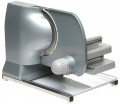Power
The total power consumption of the slicer. The value of this parameter is small — the performance of even the most powerful models usually does not exceed 200 W.
Almost all the power consumed is for operation of the engine, so the higher
it is, the more powerful the engine is installed in the slicer. Theoretically, the higher power allows you to better cope with solid and dense products, but in fact everything also depends on the characteristics of the knife — primarily its type (see below) and the quality of sharpening. Therefore, power data are more reference than practically significant, and this indicator has almost no effect on the quality of the slicer.
Min. thickness of slice
The smallest thickness of slices that a slicer can separate from the cut product.
The modern slicers, usually, allow you to adjust the thickness of the slices — an important feature in light of the fact that for different situations and products, the optimal thickness will be different. It is worth paying attention to the minimum thickness if the ability to cut graceful thin slices is important for you — for example, for serving a holiday table, on which food should be not only tasty, but also beautiful.
Pulse mode
Possibility of work of a slicer in the
pulse mode. In this mode, in accordance with the name, the knife of the device works nonuniformly — high speed alternates with short pauses. Pulse switching is well suited for working with dense and solid products: it allows you to develop a higher working speed than with uniform work, at the same time it does not allow overloading the knife and reduces the chance of jamming. However, even in such models, there is usually no question of cutting fruit pits or other equally solid ingredients — slicers are not designed for this in principle.
Material
The main material used in the construction of the slicer.
—
Plastic. This material is characterized by low cost and is often used in inexpensive models. However, its use is not an unambiguous sign that the slicer belongs to the low-cost class. The fact is that although the reliability of plastic is considered relatively low (compared to metal), it is quite sufficient even for fairly powerful models. In addition, there are many varieties of this material on the market, including options with high strength rates. Therefore, the actual strength and reliability of plastic is usually directly dependent on the price category of the slicer.
—
Metal. On the practical side, metal is remarkable for its high strength: it is much more difficult to damage such a body than plastic. In addition, it gives the device a solid appearance. The disadvantage of this material is a higher cost — despite the fact that the real need for the mentioned strength indicators is quite rare.

